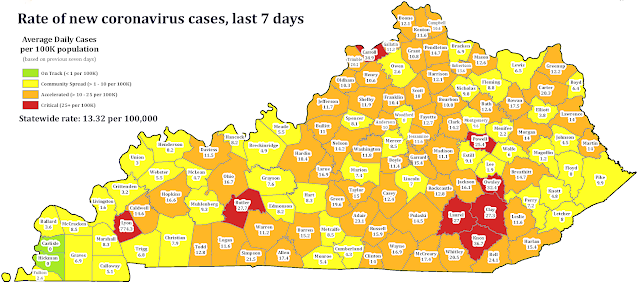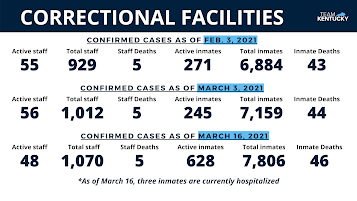Outbreak of new strain of the coronavirus at nursing home shows risk of variants, but also the effectiveness of vaccines

State Dept. for Public Health map, relabeled by Ky. Health News; for a larger version, click on it.
—–
By Bruce Maples
Kentucky Health News
An outbreak of Covid-19 in an Eastern Kentucky nursing home shows the risk of new variants of the virus, but also the power of vaccines to prevent serious illness and hospitalizations from the disease.
That was the dual message from Gov. Andy Beshear’s briefing Tuesday. After announcing that there had been an outbreak in a nursing home and saying “We believe we have detected a new variant here in Kentucky,” the governor turned to Health Commissioner Steven Stack for details and lessons.
Stack said the nursing home (which he did not identify beyond saying it was in the eastern part of the state) has 27 residents and 14 staff who have tested positive for the novel coronavirus, after 85% of its residents and 48% of its staff had been vaccinated.
Only 30% of those who had been vaccinated showed symptoms, but 83% of the unvaccinated did, showing that the vaccines “markedly reduced symptomatic disease,” Stack said. He added, “It appears that an unvaccinated person brought Covid-19 into the nursing facility.”
Five residents, including one who had been vaccinated, have been hospitalized, Stack said: “Here too, the vaccination appears to have markedly reduced the risk of serious infection and hospitalization.” Put another way, only one of the 71 vaccinated people is hospitalized, while four of the 13 unvaccinated are.
Stack said genetic mapping of the variant strain found in the nursing home is continuing, but “It looks like it’s the same infection in a group of individuals.” He said it will be compared with other variants around the country to “see if we can find any patterns or lessons we need to learn here.”
He did not say the variant was more contagious, like one that was first identified in the United Kingdom and is expected to become dominant in the U.S. But he said the presence of a new variant shows the need reduce the risk of producing more variants by allowing more infections to happen.
“We have to be very attentive about this, because the more opportunities we allow the virus to spread, the more people get infected, the more opportunity it has to mutate” and create more variants, some of which will be more dangerous, he said.
“The important news going forward is that everybody’s got to continue to get vaccinated as soon as you’re able to and eligible, and continue practicing those public-health measures we keep reminding people of,” such as masking, social distancing, avoiding crowds and good hand hygiene.
 |
| Slide displayed by Cabinet Secretary J. Michael Brown at briefing |
Prisons: The secretary of Beshear’s cabinet, J. Michael Brown, gave an update on the Covid situation in the state’s correctional facilities, highlighting recent outbreaks at the Kentucky State Penitentiary and the Western Kentucky Correctional Complex, both in Lyon County.
Brown said all state correctional facilities will be designated as vaccine distribution centers for the Johnson & Johnson vaccine, with inmates over 70 being the first to be vaccinated. When Beshear was asked about vaccinating other inmates, especially those over 60, he said those would be vaccinated once the state had received enough of the Johnson & Johnson vaccine.
The state reported vaccinating over 165,000 persons in one day, breaking the previous record by almost 40,000 vaccinations. So far the state has administered 1,026,047 vaccinations.
Ebola: After saying “This next topic is going to surprise you, though maybe nothing should surprise us during Covid,” Beshear said the state has found 11 people who have traveled to Guinea or the Democratic Republic of the Congo, where the deadly disease ebola has broken out.
He said none are considered at high risk for the disease, and the state is working with six hospitals that can be “ebola assessment facilities.” They would be contacted within 12 to 24 hours of the state learning someone had been to one of these countries and could be at risk. He said all states are following similar precautions.
Daily numbers: The state reported 819 new cases of the virus, the lowest number of cases on a Tuesday in about a month. That lowered the seven-day rolling average of new cases by eight, to 789 per day.
Also down was the share of Kentuckians testing positive for the virus in the last seven days: 3.87%, the lowest since Sept. 21. Hospitalizations for Covid-19 totaled 459, with 110 in intensive care, and 59 on ventilators. Respectively, those numbers were down five, four and eight from Monday.
The state’s overall rate of new cases over the past seven days is 13.32 per 100,000 residents. According to The New York Times, Kentucky’s rate is 19th in the nation, the lowest in several weeks. It continues to show Lyon County, site of the prison outbreaks, having by far the nation’s highest rate. The state says the county’s rate is 788.2; other counties with rates more than double the statewide rate are Knox, 43.6; Clay, 34.5; Owsley, 32.4; Laurel, 28.4; and Carroll, 26.9. Only eight of the state’s 120 counties are in the “red zone” for those averaging more than 25 cases per 100,000 over the last seven days.
The state added 24 more cases to its list of Covid-19 deaths today, bringing its total to 5,029. The fatalities were a Ballard County man, 86; a Bell County woman, 90; two Boone County men, 51 and 81; a Boyd County woman, 86; a Boyle County man, 61; a Bullitt County man, 88; two Campbell County men, 63 and 88; a Fayette County woman, 82; two Fayette County men, 62 and 74; a Gallatin County woman, 63; a Jefferson County man, 81; two Kenton County men, 64 and 72; a LaRue County man, 63; a Lincoln County man, 79; a Marion County man, 65; two Mercer County women, 82 and 84; two Pulaski County women, 70 and 91; and a Whitley County woman, 81.
Other pandemic news Tuesday:
- A study of 25,000 health-care providers, published in JAMA Network Open, found that health- care workers are more likely to catch the coronavirus at home or in their community than on the job, HealthDay News reports. Researchers found the strongest risk of infection was known exposure to someone in the community who had tested positive for the virus, as well as living in a ZIP code with high incidence rates.
- An op-ed on overcoming vaccine hesitancy in MedPage Today lays out what behavioral science teaches us about changing the hearts and minds in vaccine hesitant individuals. It concludes: “Covid-19 vaccine willingness is a complex, multifactorial decision-making process. People weigh perceived risks and benefits and are influenced by barriers, cues, and self-efficacy. Addressing the way these factors manifest in diverse populations could spark a movement of vaccine confidence.”
- Kentucky ranks 29th when it comes to the share of residents who are fully vaccinated, according to the Centers for Disease Control and Prevention data tracker. It shows 11.95% of Kentucky’s population has been fully vaccinated. The range is between 8.19% in Utah and 18.3% in Alaska.
- Axios explores why only a minority of Covid-19 patients are receiving some of the most promising antibody coronavirus treatments, shown to prevent hospitalization and death among high-risk people with mild or moderate cases. A huge issue is that patients must get diagnosed early, and often have to initiate a conversation with their provider, who then must connect them with a treatment center; and then they must get there. The process “puts a burden on the patient that typically in the health care transaction they don’t have,” Janelle Sabo, who leads Covid-19 therapeutics at Lily, told Axios.